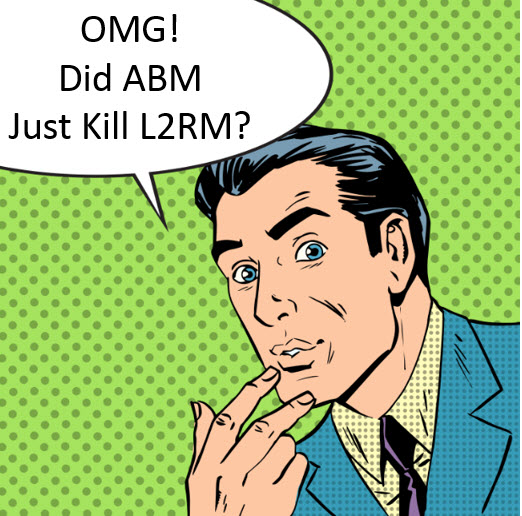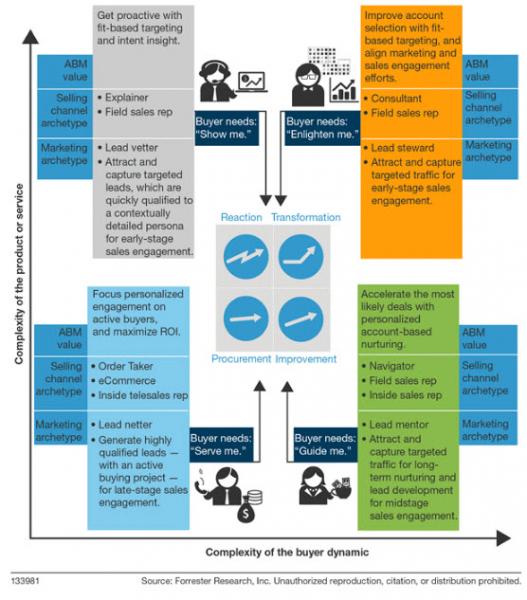Account-Based Marketing Will Elevate, Not Eclipse, Lead-To-Revenue Management
 The explosion of interest in account-based marketing has created uncertainty for business-to-business (B2B) marketers who have invested in marketing automation to optimize their lead-to-revenue processes. It’s not surprising because the vendors that market ABM-badged wares – and many pundits — generate attention with controversial proclamations, like: “ABM is the death of demand generation”; “ABM replaces inbound marketing” and “Lead to Revenue Management (L2RM) is only a suitable strategy for selling products and services to small businesses”.
The explosion of interest in account-based marketing has created uncertainty for business-to-business (B2B) marketers who have invested in marketing automation to optimize their lead-to-revenue processes. It’s not surprising because the vendors that market ABM-badged wares – and many pundits — generate attention with controversial proclamations, like: “ABM is the death of demand generation”; “ABM replaces inbound marketing” and “Lead to Revenue Management (L2RM) is only a suitable strategy for selling products and services to small businesses”.
While these arguments might help hawk new technology, they create confusion about both ABM and L2RM. It’s not surprising that 73% of B2B survey respondents agree that, as an industry term, ABM lacks specificity and gets applied to many different approaches inconsistently. In my most recent report, Account-Based Marketing Will Elevate, Not Eclipse, Lead-To-Revenue Management (subscription required), I set out to rationalize the concepts of ABM and L2RM.
Key takeaways:
- B2B marketers should use ABM to accelerate the pivot to customer obsession.
- B2B marketers need to decompose ABM into its component parts: strategy, tactics and technology.
- Forrester's Go-To-Customer Strategy Matrix helps B2B marketers fine-tune their ABM strategy.
Vendors use the term "ABM" to denote capabilities ranging from company-targeted advertising to social intelligence, predictive analytics, and account-centric data management and reporting. And B2B marketers apply the term to an equally diverse set of tactics. In the interviews that we conducted for our report, B2B marketers described using ABM tactics that ranged from the simple (e.g., identifying the target list for an event promotion) to the sophisticated (e.g., targeting best-fit accounts with online, mobile, and social advertising)
Rather than replacing L2RM, we found that account-based marketing helps deliver the L2RM vision:
- L2RM is a strategy for B2B marketers to catch up to their evolved buyer. Forrester introduced the concept of L2RM in 2010, defining it as a business system for marketers whose offerings mandate a long, complex, or highly considered buying process. It comprises integrated goals, processes, and metrics that reshape marketing practices to drive effective customer engagement across the entire customer life cycle — from awareness to advocacy.
- ABM enriches the lead-to-revenue practice with account-specific tactics. Forrester defines ABM as a strategy through which marketing and sales jointly obsess over how to pursue, establish, and grow long-term, highly engaged revenue relationships with specific customer accounts. An ABM strategy, along with all of the technologies and tactics that enable it, enriches the lead-to-revenue practice with insights, metrics, reports, plans, content personalization, and orchestration tools. These all help marketing and sales use account-specific knowledge to deliver customer-obsessed experiences.
Our research revealed many ways in which ABM tactics, techniques, and technologies can improve L2RM outcomes. Forrester believes that — at some level — ABM applies to every B2B marketer, even though 21% of the marketers we surveyed for this research felt that ABM was not relevant to their situation. But, before B2B marketers can assess how to apply ABM properly, they need to deconstruct ABM and look at its component parts:
- A strategy that focuses on a select set of companies.
- Deep account insights that inform tactics.
- Technology that enables personalized contextual marketing at the individual and account level.
Forrester's Go-To-Customer (GTC) Strategy Matrix helps B2B marketers and sellers identify which ABM strategies, tactics, and technologies can most effectively improve execution results in each of four different archetypal buying journeys.

